|
Related FAQs: Life
of the Tropical West Atlantic, Tropical West Atlantic 2,
Related Articles: Algae,
Vascular Plants, Introduction
to Fishwatcher's Guide Series Pieces/Sections, Lachnolaimus maxiumus/Hogfish, Hogfishes of the Genus
Bodianus,
Invertebrates, Algae and Vascular
Plants of The Tropical West Atlantic: Bahamas to Brazil, Part
1
To: Part 2, Part 3, Part 4,
Part 5, Part
6, Part 7, Part 8, Part 9,
|
 
|
| Bob Fenner |
BGA, Algae
|
Marine Algae of the TWA:
| Though it's not the "right" color,
this is assuredly Cyano/BGA... slimy, black, brown, blue, green,
red appearing... present wherever the reef is damaged, overly
challenged. |

|
Greens:
|
Acetabularia
Bahamas
|
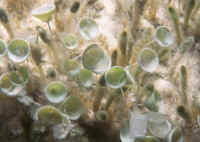
|
| Halimeda species are
crusty, calcified algae that look like a bunch of small platelets
strung together in a chain. They are good choices if you have a lot
of grazers, as it is tough to chew. Pictured below: the genus in
the Bahamas, in a saltwater tank, and in fifty feet of water in
Fiji. At right: Halimeda opuntia off of Cancun,
Mexico. |
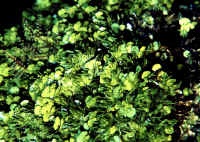
|
| Halimeda discoidea, Large Leaf Watercress
Alga. To eight inches tall, 1" segments. Disk-like segments
joined by flexible joints. A commonly occurring species in the
tropical West Atlantic, and extensively used in marine aquariums.
Bahamas pic. |

|
| Halimeda goreaui, Small Leaf Hanging Vine.
Tropical West Atlantic. To a foot in length, segments to 1/4"
diameter. Chains of small, three-lobed segments. Grow in subdued
lighting. Bahamas pic. |
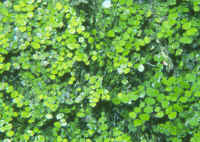
|
| Halimeda macroloba N. Sulawesi images of
healthy and calcium carbonate skeleton remnant colonies. |
 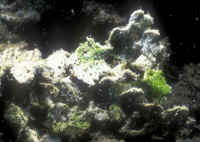
|
| Halimeda monile 3-8 inches tall. Here in
Jamaica. |

|
| Halimeda tuna, Stalked Lettuce Leaf Alga. To
ten inches in height, 3/4" segments. Tropical West Atlantic.
Stalked uniplanar colonies which branch as they grow outward.
Cozumel image by Di.F. |
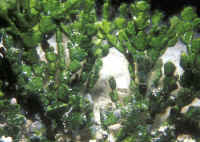
|
| Neomeris annulata, Caterpillar Weed, Fuzzy
Tip Alga. Below: Aquarium, Cozumel and N. Sulawesi close-up
images. |
|
Penicillus dumetosus, Bristle Ball Brush.
Tropical West Atlantic. To six inches in height. Belize, Cozumel
and an aquarium specimen shown below.
|
| Penicillus pyriformis, the
Merman's Shaving or Flat-Top Bristle Brush is a tuft of
bristles rising out of a vertical stalk. Take care to gently place
these in fine sand. Cozumel pix including typical sandy
habitat. |
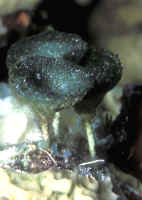 
|
| Rhipocephalus phoenix, Pinecone Algae. To
five inches in height. Look like pinecones of sorts, with
overlapping thalli growing outright from a single, attached stalk.
Cozumel image. |

|
|
Udotea looks like a soft green fan(s), some
individuals having more than one. Two views of shallower water
and older, deeper water colonies in the Bahamas and a grouping in
Cozumel.
|
| Udotea cyathriformis, Mermaid's Tea Cup.
To six inches in height. Thin walled cups attached to a single
stalk. Easily torn in handling. Tropical West Atlantic in shallow
sandy bottoms and coral rubble zones. Cozumel image by Di.F. |
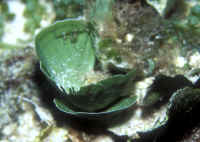
|
| Dictyosphaeria cavernosa. See Valonia below.
Shots in Belize and Hawai'i. |
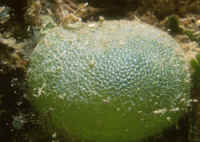

|
| Valonia macrophysa, Elongated Sea Pearls. To
3/4" in diameter. Spherical to elongated shiny
"balls" of silvery appearance that grow in clusters. Here
in Cozumel. |

|
| Valonia (Ventricaria)
ventricosa is often noted as the "largest single-celled
alga" reaching a hen's egg in size... but it is actually a
multinucleate vesicle held down by attachment rhizoids.
Dictyosphaeria species, in the same
group, Order Siphonales, are similar with polygonal vesicles,
versus lenticular ones for Valonia. Mithrax/Emerald Green
Crabs may eat these. |
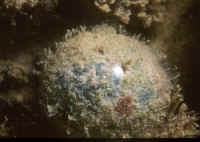
|
Caulerpas:
| Caulerpa prolifera, likely
the most common species (of many) in use in marine aquariums.
Originates out of both coasts of the Atlantic in warm waters and
the Mediterranean. |
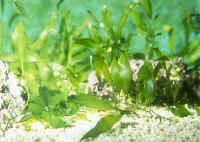
|
| Caulerpa racemosa, Green Grape
Algae. At right in Hawai'i. Below: A close up
and not in Cebu, P.I., and Cozumel |
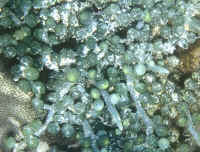
|
|
Caulerpa sertularoides
Aquarium and Belize images
|

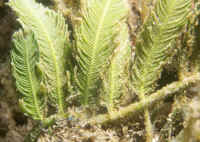
|
Brown Algae:
| Dictyota species, cold to cool to tropical
species (plural). Some examples of colonies: right, a reddish
patch in N. Sulawesi, below in Cebu (Philippines), and two more
bluish ones in Cozumel (Mexico) by Di.F. |
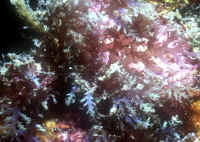
|
| Lobophora variegata, Encrusting Fan-Leaf
Algae. Fan-shaped blades that encrust rock. Occur in brown, red,
green colors as shown in this image made in the Bahamas. And a
Lobophora sp. in Redang, Malaysia, and last, St. Thomas,
U.S.V.I. The genus is found in both the Indo-Pacific and
Caribbean. |
| Padina sp., Scroll Algae, a
calcium carbonate encrusting Brown Algae in the wild or marine
aquariums. This is Padina jamaicensis in Belize. |

|
| Sargassum hystrix, White-Vein Sargassum.
Distinctive white central areas on green to brown thalli. Common in
the tropical West Atlantic. 4-16 inches in height. Bahamas
pic. |

|
| Stylopodium zonale, Leafy Flat-Blade Alga.
Flat blades that are irregularly split and branched. Attached to
hard substrates. Cancun, Mexico. |
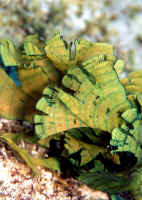
|
Red Algae:
|
Amphiroa foliacea
This one in Tobago.
|
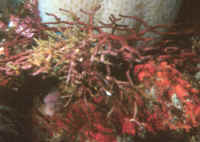
|
|
Jania, a tropical genus of jointed
corallines; found in South Africa, South Australia and Southern
California! This one in Belize.
|

|
| Jania adherens, Pink Segmented Alga. Appear
as fine, tangled clumps. Widely separated dichotomous branching
made up of tubular segments and flexible joints. Pink to red with
white joints. |
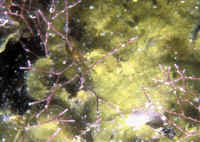
|
|
Lithophyllum the most widespread genera of
marine algae are this and Lithothamnion, rock encrusting
forms; all reefs, reef-tanks, both poles and everywhere
in-between to 500 feet depths! Thin calcareous films to knobby,
stony masses.
|
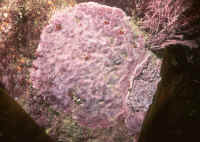 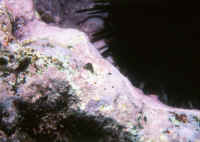
|
"True" or Vascular Plants... Aquatic and
Transitional
| Rhizophora mangle, the Red Mangrove. Of the
many species, indeed families of mangrove trees, this is likely the
most commonly utilized by aquarists. Up to 22 meters tall in the
wild, capable of breaking the strongest of aquarium construction
materials. Most common complaint is loss of magnesium ions (along
with sodium pumping), resultant calcium imbalances in closed
systems. Keep an eye on Mg concentrations, supplementation. A
bioassay is yellow of the tree leaves. |
 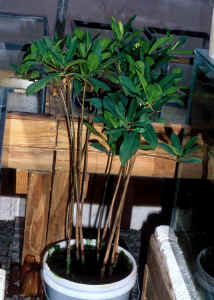
|
| Syringodium filiforme, Manatee Grass. To
eighteen inches tall, forty feet depths. Cylindrical leaves
upright, grow by runners. Often found mixed with Turtle Grass. St.
Thomas, U.S.V.I. & Jamaica |
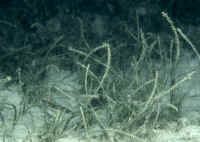
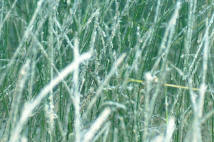
|
| Thalassia testudinum, Turtle Grass. Up to 2
ft. tall, 1/2" width. Found in shallows to 65 foot depths.
Tropical West Atlantic in sand, mud beds in which it firmly anchors
itself. A young bed/stand in St. Thomas, U.S.V.I. |
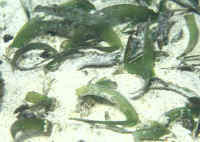
|
| Zostera marina in an a home aquarium. Yes,
vascular (true, embryophytic) plants can be used in marine fish
tanks. This pic from a tank tour in Los Angeles. |
 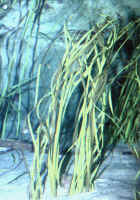
|
To: Part 2, Part
3, Part 4, Part
5, Part 6, Part
7, Part 8, Part
9, Part 10, Part
11, Part 12, Part
13, Part 14, Part
15,
|
|

